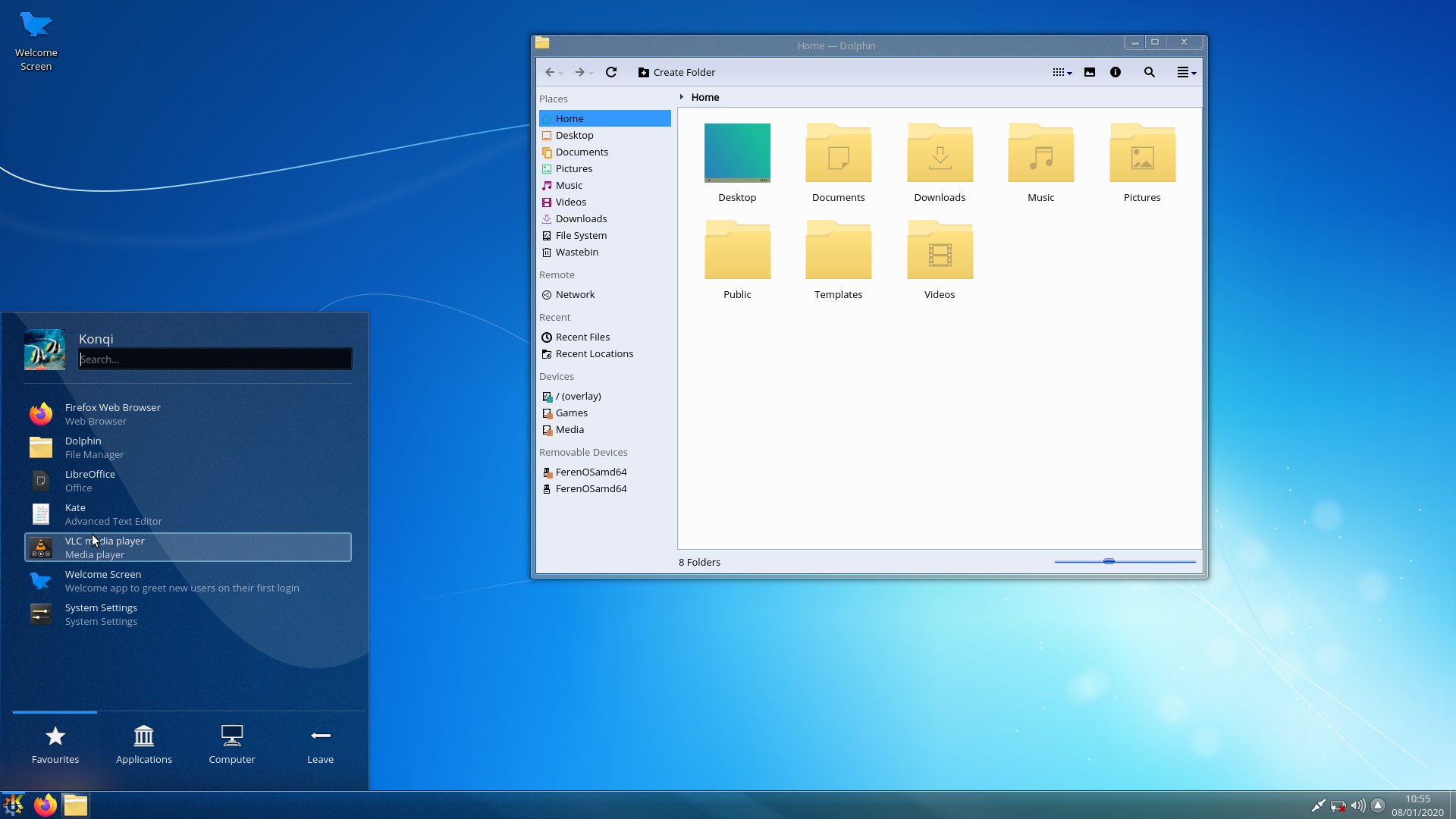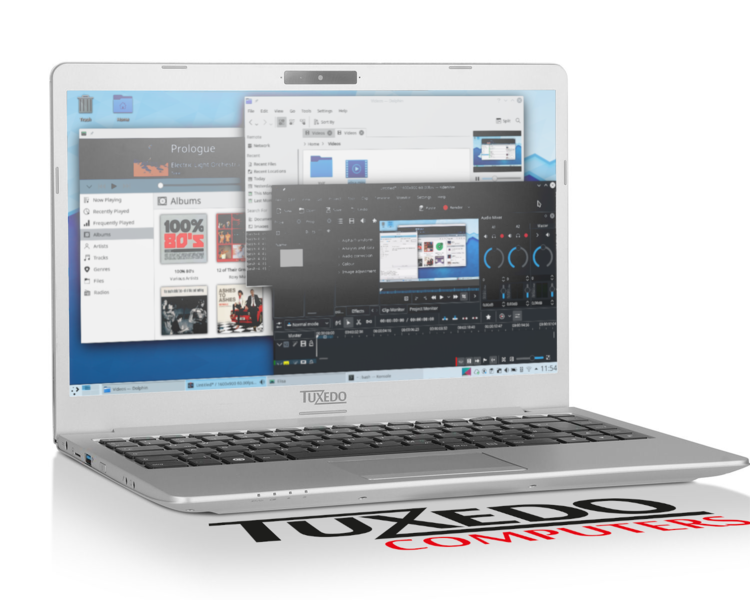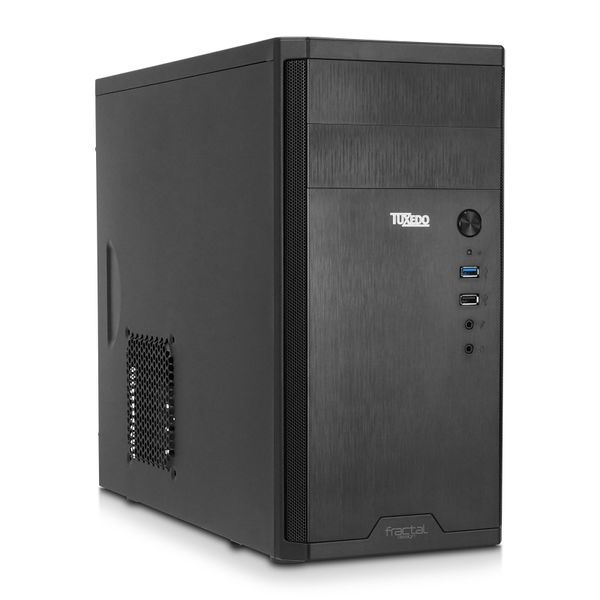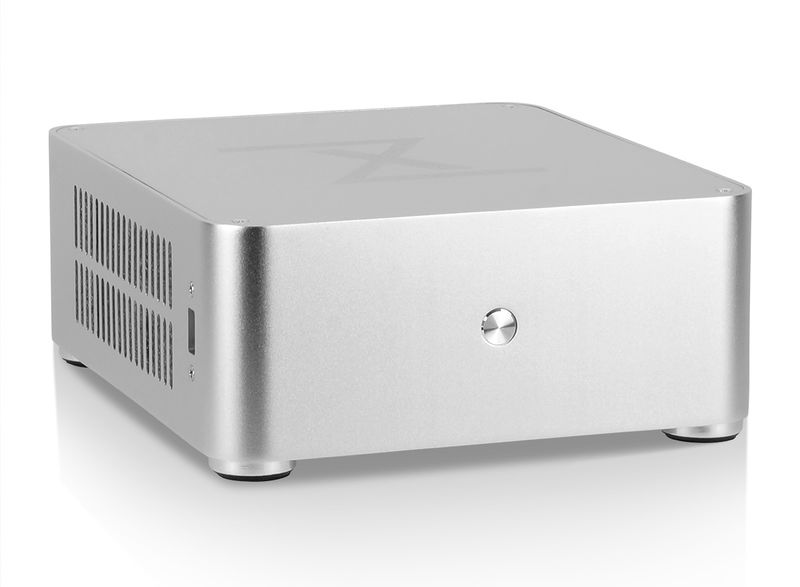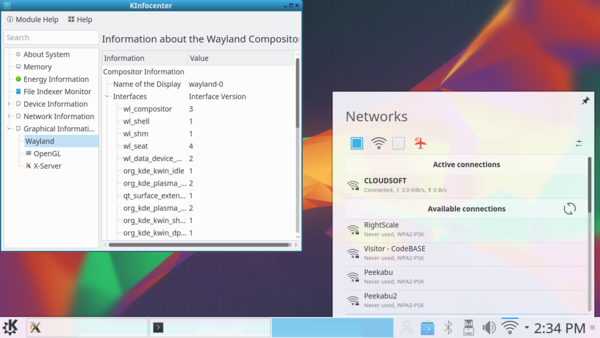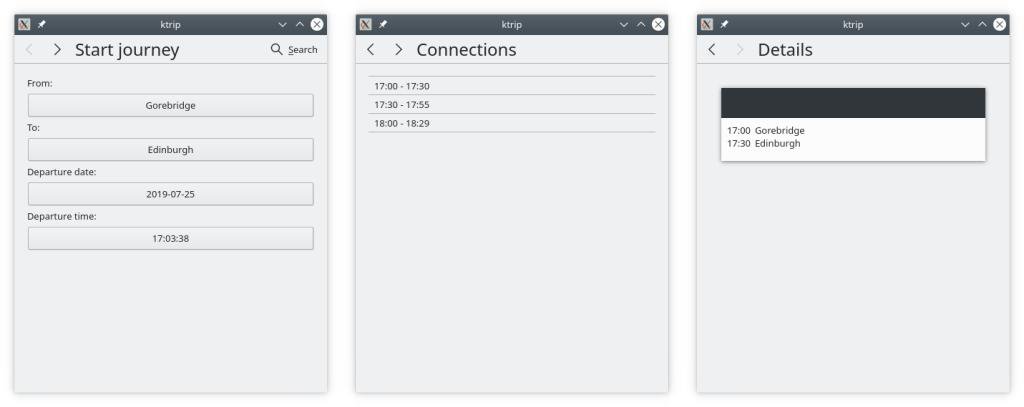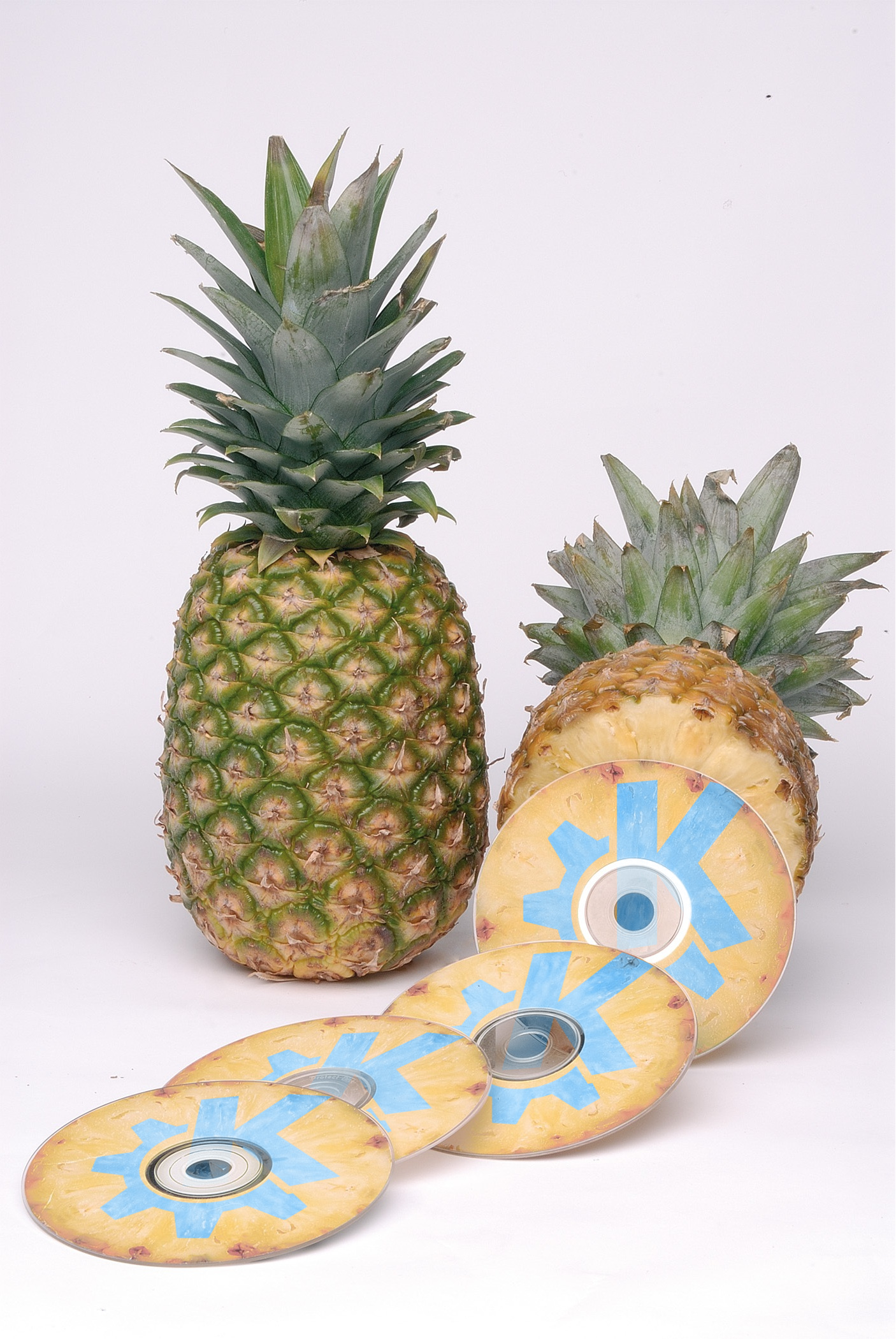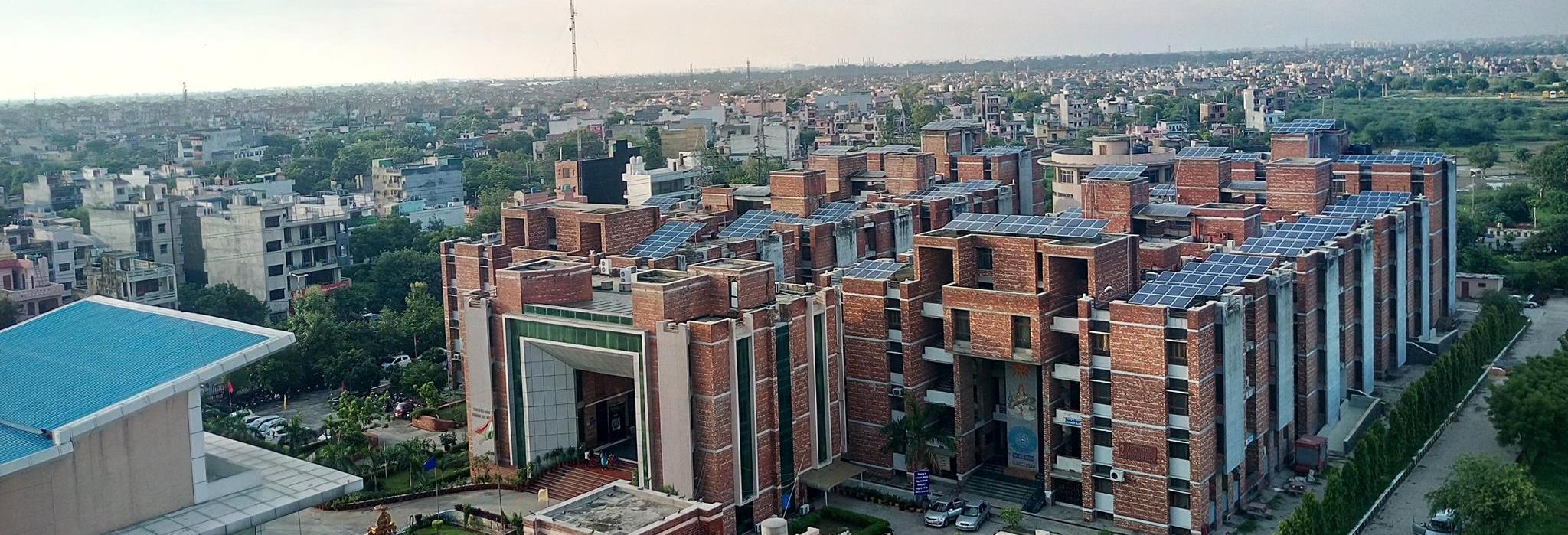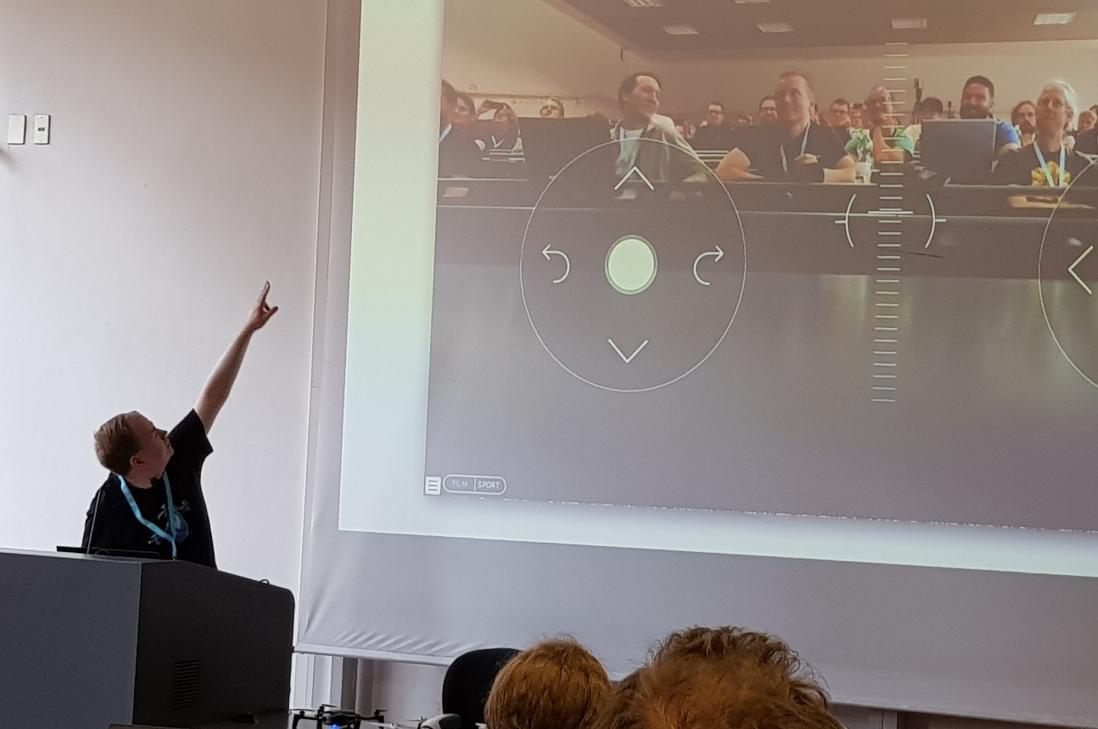Applications
-
Plasma: A Safe Haven for Windows 7 Refugees
(KDE)
Microsoft will stop providing updates for Windows 7 on January 14 2020.
There won't be any more patches that correct bugs or even dangerous vulnerabilities. This will leave Windows 7 users exposed to all sorts of bad stuff. But that is not a huge concern for Microsoft. With this move, Redmond hopes to encourage users to upgrade to Windows 10.
But why should we care? Maybe because Windows currently holds 77% of the global desktop market share (all Linux desktops combined hold less than 2%). Of that 77%, nearly 30% belongs to Windows 7. That is nearly a billion people still holding on to Windows 7 because they are resisting the move to Windows 10. Apart from the natural human resistance to change, Windows 10 has earned a bad rap as an operating system that will gladly leak your data back to Microsoft and lace your desktop with intrusive advertisements as a matter of course.
Helping people regain control over their systems and protecting their data is precisely what Free Software communities do best, making this the perfect opportunity to help Windows 7 users upgrade to something much better: To the Plasma desktop!
How you can help
We need you to help convince Windows 7 users to move to the Plasma desktop. We have set up a task where we are brainstorming ideas, advice and resources. You can contribute your thoughts too. Get your KDE Identity today and join the conversation.
You can also join the Promo team live on Matrix and help us run this campaign.
Or fly solo! Talk to your friends, family, classmates and colleagues. Even if you convince just one person to make the transition to any Linux-based system, you will have done something valuable and helped the FLOSS movement.
The Windows 7-like theme shown above was put together (from many parts created by many generous contributors) by Dominic Hayes, creator of Feren OS, a cool-looking Ubuntu-based Linux distro aimed squarely at end users. Check it out!
Dominic used the following elements to re-create the look and feel of the desktop:
Plasma Theme: Seven Black
Window Decorations: Seven Black
Application Style: gtk2
GTK Theme: Windows Se7en by Elbullazul
Icons: Darkine
Colours: Breeze Light
Cursors: DMZ White
Splash Screen: Feren OS
Panel: 38 height
Widgets: Default Apps Menu, I-O Task Manager, Stock System Tray, Feren Calendar or Event Calendar, Win7 Show Desktop -
KDE is All About the Apps: October Update
(KDE)
KDE is all about the Apps!
We are a community of thousands of contributors who make hundreds of Apps using collaborative open source methods. Our apps run on Linux with Plasma, of course, but also fit in well with GNOME, Enlightenment, XFCE, or any other desktop you happen to be using. Many of our apps run on Windows, Android and macOS.
A new goal for the KDE community is to push how we are All About the Apps. We will be highlighting our best software and promoting it to increase its adoption outside the circle of current KDE fans (who we still love very much!). This is a monthly update of what's new in our apps. If you'd like to help out with this community goal, take a look at the All About the Apps workboard, and join us in our Matrix chat channel.
App Updates
The elite painting app Krita received a monthly bugfix release, 4.2.7. The developers have improved the layout and functionality of the color selection dialog, and made it possible to save group layers to file layers even if they are empty. The sort order of images imported as frames was fixed, a bunch of crashes removed, and dozens of other bugs tidied up.
To celebrate, the Krita team also made a video with artist Ramon Miranda that offers some advice for improving your sketches. Krita is available in your favorite Linux distribution, for Windows, macOS, as a Linux AppImage, on Flathub, and in the Snap store.
KMyMoney, the app for managing your finances, also got a new release - 5.0.7. This release introduces updates required for the new regulations of the Payment Services Directive, which affects the online capabilities for German bank users.
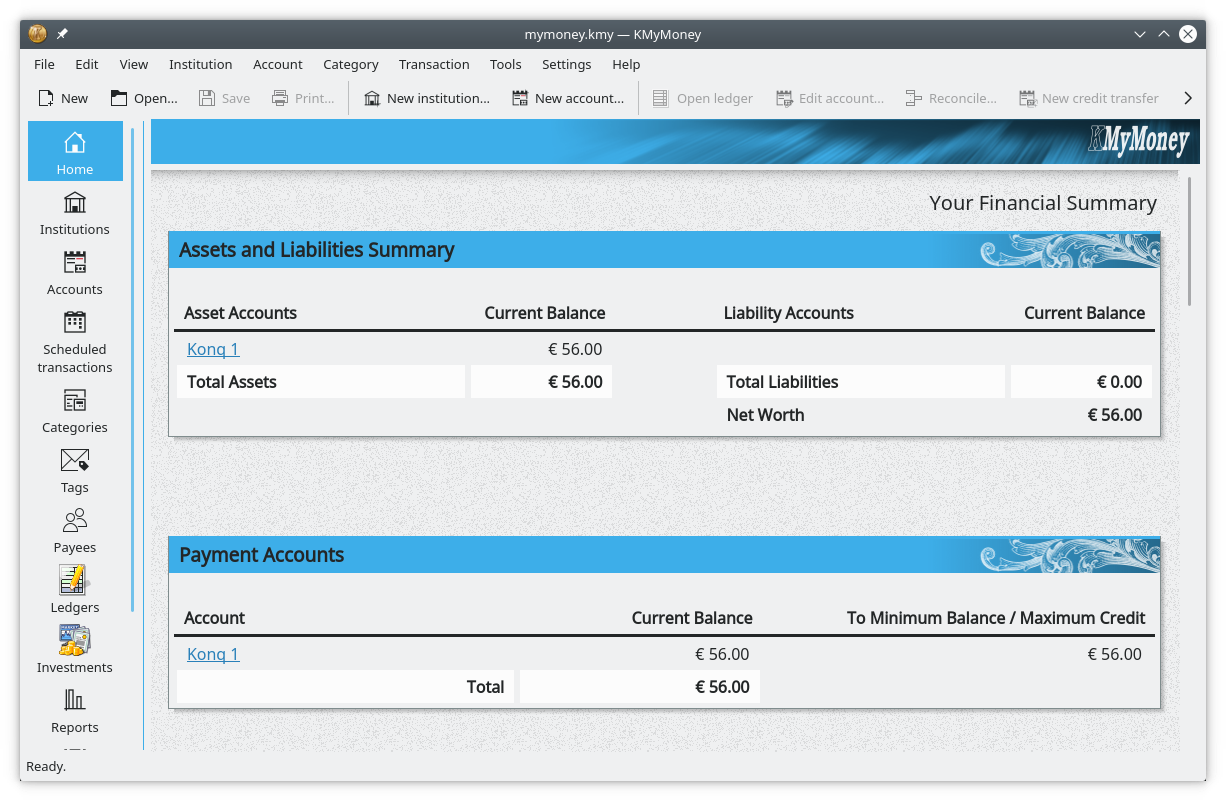
To make KMyMoney compatible with those regulations (especially the strong customer authentication part), developers had to adapt it to updated APIs of the Gwenhywfar and AqBanking libraries which provide the banking protocol implementations.
Coming from KDE and used by many of us, the distributed compiler cluster Icecream and Icecream Monitor have been updated. The new release improves Objective C and C++ support, removes hardcoded compiler paths, and fixes job preloading to again allow sending one extra job to a fully busy node. In the monitor app several new ice cream flavors have also been added, we're not quite sure what this means but it sounds delicious.
In the last month, Latte Dock (panel for the Plasma desktop) had two new releases, making improvements to its new Win Indicator look.
KDevelop, the discerning coder's IDE, published a bugfix release - 5.4.2. You can get it from your Linux distribution or as an AppImage, and you can also compile versions for Windows and macOS.
RSIBreak, the app that helps you prevent damage to your wrists got a new release versioned 0.12.11.

Photo management and editing app digiKam released the version 6.3. The highlight of the new release is the G'Mic plugin.
G'Mic is the image processing library with over 950 different filters, so you can make all your photos truly beautiful. digiKam can be installed from your Linux distro, AppImage bundles, macOS package, and Windows 32/64-bit installers.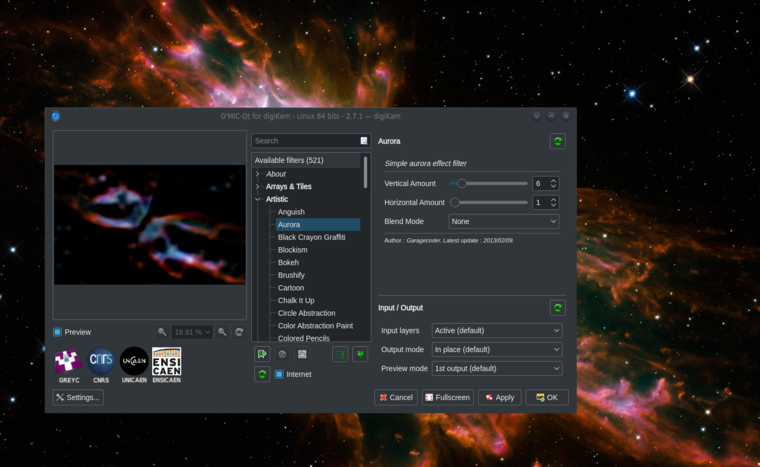
Telescope and astronomy app KStars also had a new release, versioned 3.3.6. The KStars Live Video window can now show debayer frames in real-time, making it possible to create color video streams.

The weather data can be directly displayed in the Observatory Module, and the user interface has been improved in a number of ways. As one of the most feature-rich free astronomy apps, KStars caters to a wide variety of use cases, so you will surely find tools that are useful to you regardless of your level of experience. KStars is available pretty much everywhere - as a Windows installer, macOS installer, Android app, Snap package, and in your Linux distribution.
Bug Fixes
We are continually improving our apps, so plenty of bug fixes have been made. Here are some highlights.
- Our document viewer Okular gained support for HighDPI screens. This one-line fix to add automatic scaling based on the pixel density of the monitor will make viewing documents on fancy monitors so much better.
- The advanced text editor Kate was similarly updated to work with HiDPI screens throughout.
- The chess game Knights had a one-line fix in version 19.08.2. Thanks to the fix, you can now start a game when the second player is a computer engine again.
- Video editor Kdenlive fixed screengrabs in Linux to eliminate crashes, and in Windows to correctly grab the audio.
- CD burner app K3b fixed a crash where it couldn't find the supporting command-line tool mkisofs.
Supporting Bits
Libraries and artwork support our apps to make our software work beautifully.
The Breeze icon theme got new icons for activities, trash, batteries, QR codes, and more. Libical, which is used by Kontact to talk to iCalendar protocols and data formats, had a bugfix release (3.0.6).
Snorenotify is a notification framework supporting Linux, Windows and macOS. Snoretoast is a command-line application used within Snorenotify for Windows Toast notifications. It is also used in Quassel and Tomahawk, and the good news is that it got a new release this month (0.7.0).
New in App Stores
Our software is increasingly available directly through app stores. To celebrate and highlight this (and to help you find them more easily!), this month we added Windows Store links to the KDE Applications web page.

More KDE applications found their way to the Windows Store:
Welcoming New Projects
New projects are started in the KDE community all the time. When those projects are ready for wider use, they go through a process called "KDE review", where other KDE contributors will check them for code quality, features, licensing, and how well they work on different platforms. Last but not least, we decide whether we are happy to give it the KDE stamp of approval.
In KDE review this month is Ruqola, a chat app which talks on the Rocket Chat network and uses the Kirigami UI framework. For the more technically-inclined, Elf-Inspector is an app providing tools for inspecting, analyzing, and optimizing ELF files (the executable file format used on Linux).
Saying Goodbye
Sometimes, apps are left behind when their code does not keep up with the rest of the world.
This month, a new version of our multimedia library Phonon was released. In this version, we removed Qt4 support - sensible enough, as Qt4 hasn't been supported since 2015. As a result, the music player app Amarok has become deprecated (at least for now). Don't lose hope, though: the Qt5 port is progressing, but it's not there yet.
The web browser Rekonq was marked as unmaintained, meaning it's unlikely to ever come back. However, the work carries on in Falkon, so make sure to check out and support the project if you are interested in lightweight web browsers. Also considered unmaintained is the bootup configuration tool systemd-kcm.
Enjoy your apps from KDE, and stay tuned for more updates!
-
How KDE Celebrates 20 Years
(KDE)
KDE is 20 years old, a community working on beautiful software to free the world and spread privacy, all while having a lot of fun which we do it.
In cities across the world there are parties being held this weekend to celebrate. As we write the KDE Korea party in Seoul is setting up for some talks and drinks.
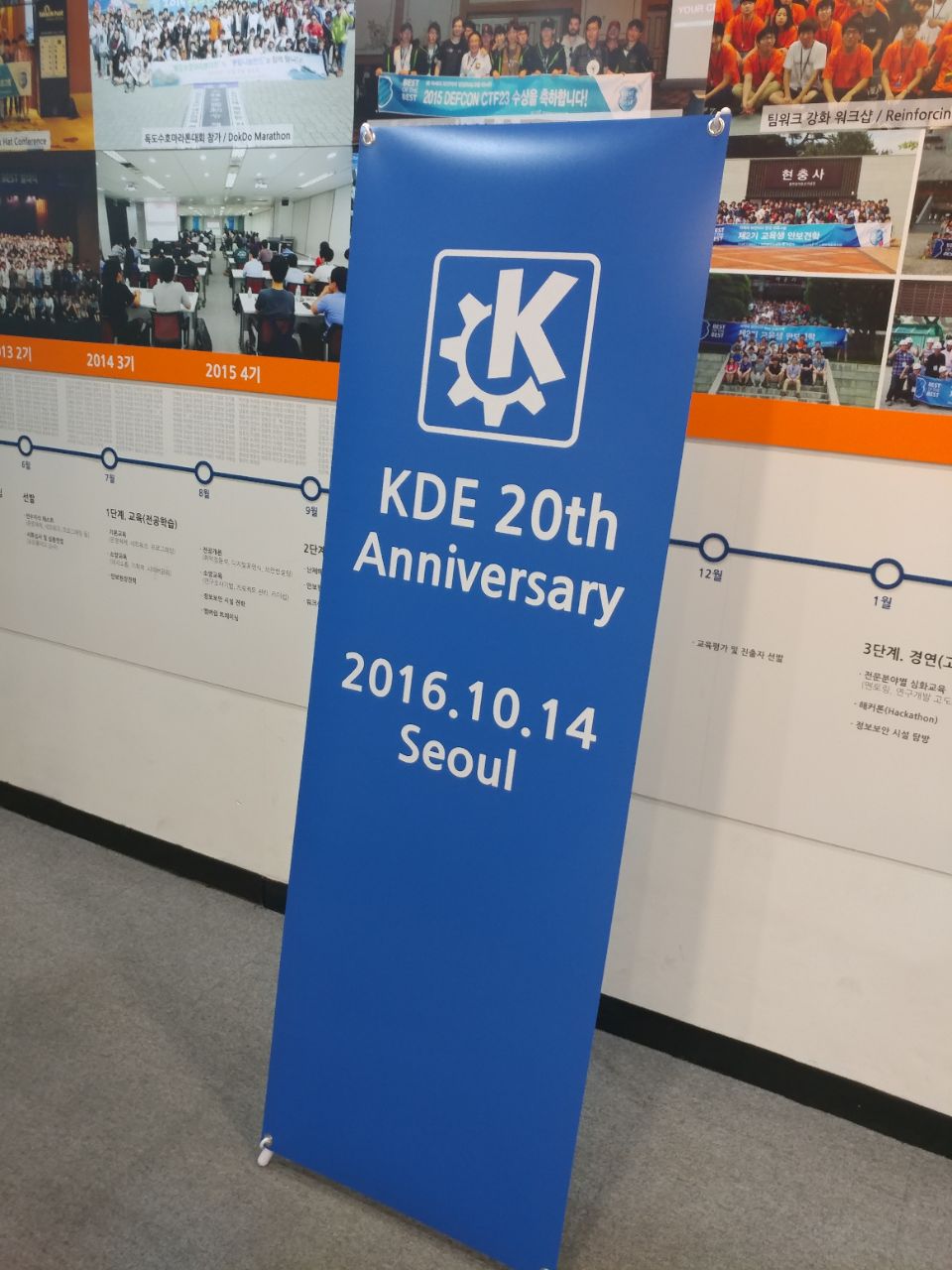

Some 20 year parties have already been held such as at FISL in Brazil last month.
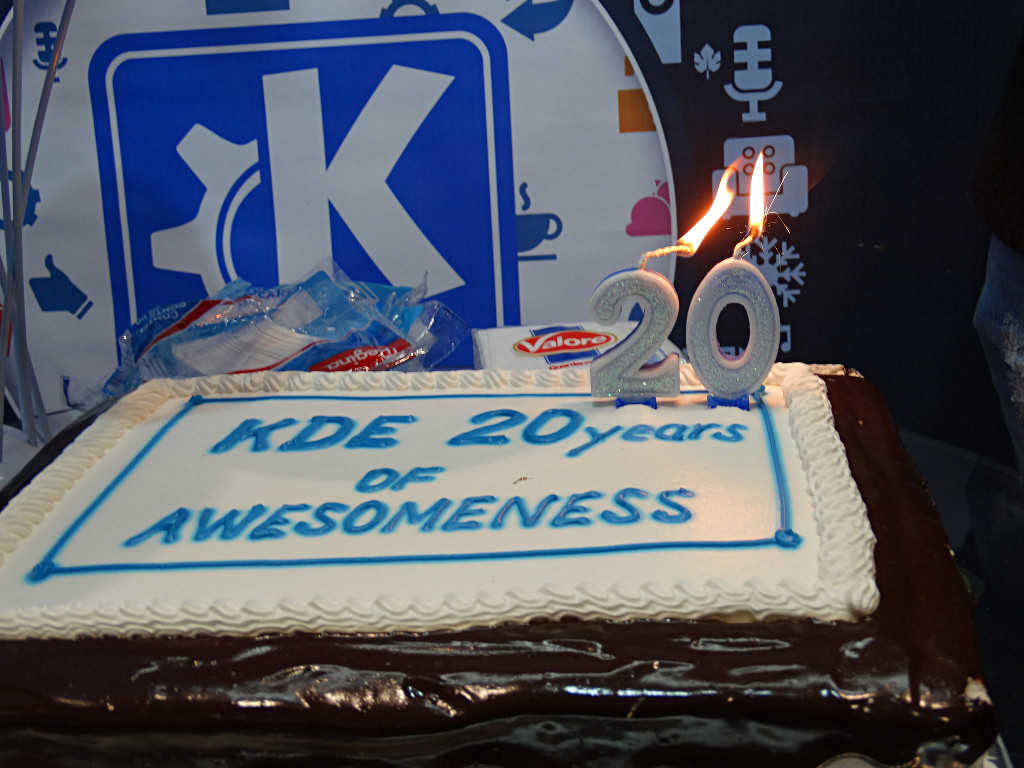
Showing the strength of the KDE development community, our flagship product Plasma released its first Long Term Support edition. The Linux Action Show, never ones to shy away from critisism, give it a thorough review and decided it was "light years ahead" and had "more compelling features" than the competition.
And if being 20 years old makes you feel old you can look back at the latest release, KDE 1. Helio has brought the classic version back to life. There are even Docker images you can install yourself from KDE neon.
If you haven't read them already take a look at the 20 Years of KDE timeline and download or buy the 20 Years of KDE book.
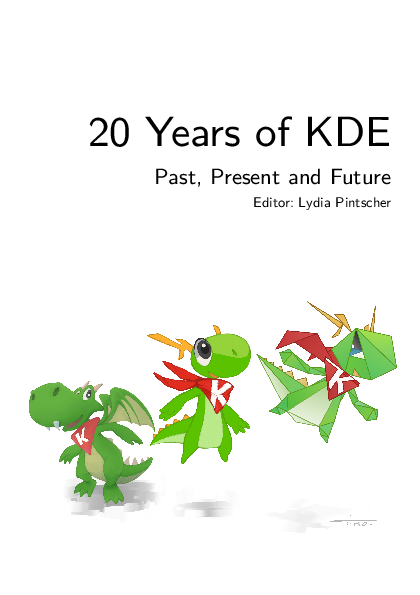
Brazilian IT website Vida de Suporte did a special comic for KDE:

Support: Hey, look, KDE is 20 years old!
Intern: Oh, damn it, I tougth it was a pokemon.Let us know how you celebrate this anniversary how what you think KDE can do in the next 20 years to spread freedom, privacy and community.
Comments welcome here or on Reddit thread.
-
Announcing KDE Plasma 5.18 Wallpaper and Video Contests
(KDE)
By Niccolò Venerandi

KDE wants you to create the next wallpaper for Plasma 5.18 and the promotional videos for Plasma and applications of KDE.
The chance of getting your work seen by thousands of people and organizations worldwide, including at NASA and CERN, is within your grasp! You can also win some really astounding prizes courtesy of our friends at TUXEDO Computers.
Prizes
The winner of the wallpaper contest will have their work included as the default background on KDE's upcoming Plasma 5.18 desktop. This means you will not only earn the admiration of thousands of Plasma users, but you can also win a very cool TUXEDO InfinityBook Pro 14 computer.
More details about the InfinityBook Pro are available on the Wallpaper Contest's page.
Is fillmmaking more your thing? Try your hand at shooting and editing an exciting promotional video for Plasma or for applications KDE makes. The winners of the best Plasma promotional video will win a TUXEDO Gaming PC, and if you win the best Applications video competition, you'll get a TUXEDO InfinityBox.
You can read about the specs of each machine on the Video Contest's page.
Twelve finalists will also receive a package of goodies containing among other things:
- A KDE Baseball cap
- A plush Tux
- KDE Stickers
- A frozen glass coffee mug
How to Participate
Taking part is easy! Check out the rules for Wallpaper Competition and send in your masterpiece. Remember that, in order to submit a wallpaper, you need to follow the link to the appropriate subforum where you can create a new post. You can also find suggestions and helpful material on the webpages.
Want to make a video instead? Read the rules for the Video Competition carefully and start shooting your clip!
We can't wait to see what you will create!
-
First Plasma Wayland Live Image
(KDE)
The Plasma team has been working on an early Christmas present: a live image running Plasma on Wayland.
Being able to run a full session of Plasma with applications is a major milestone in our aim of moving from the 30 year old X Window System to its replacement.
The central component in this is our window manager, KWin, which has moved from drawing borders on the edges of windows to running the full compositor and talking the Wayland protocols which allow applications to draw on screen and be interacted with.
Users of the image will notice some obvious glitches, it is certainly not ready for everyday use yet, but the advantages of more secure workspaces, easier feature extendibility and graphics free of tearing and gitches will be appreciated by everybody. Work on this has been ongoing since 2011 and is expected to take years rather than months before a completely transparent switch away from X will be possible. Find more about the project on the KWin Wayland wiki pages.
Congratulations to Martin Gräßlin and the rest of the Plasma team on making this possible.
To try it out: download the live image, carefully use
ddto copy it to a USB disk and reboot from that disk. Unfortunately it won't work from a virtual machine yet.- Plasma Wayland 20151218 Live Image [1.2GB download]
-
Luca Toma KDE Interview
(KDE)
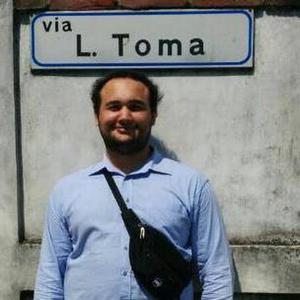
Luca TomaGoogle Code In is our annual project to give tasks to school pupils to contribute to KDE projects. One task this year is to write a Dot article and top Code In student Stanford L has interviewed WikiToLearn contributor and Sysadmin Luca Toma.
Please tell us a little about yourself
I am a second year physics student studying at the University of Milan Bicocca. I’ve been passionate about computers since the age of 10, especially the part of sysadmin / networking.What do you do for a living?
Currently, I am a student and I work within an office that deals with management of business systems and website development.What do you do for KDE?
At this time my contribution in KDE is WikiToLearn, my role is the system administrator. I take care of the maintenance of the infrastructure and server project.
How did you get into computer programming?
I started programming when I was 12 years of age, I was intrigued by a friend working on a GNU/Linux distribution using Bash, just like in the movies. I started with VB6, after which was passed on to C / C ++, in order and PHP.Do you have any advice for people who would like to pursue computer programming as a major?
My advice is to write the code on what you know to be able to understand what you want and to be able to make the most out of it.Who is your role model, and why?
I do not have a well-defined role model because I try to take inspiration from the best of all. Einstein created a model for what concerns thinking in their own way and I think it is extremely important to be able to solve problems in the best way.What are some ways you motivate yourself?
One thing that motivates me is to do my best.
I think if each one of us always did their best in situations, it would be the best for everyone.Do you have a vision, like where do you want KDE in general to be in 5 years and sysadmin in particular?
I hope that KDE will become a reference point for all those who want to learn computer science.
A community that is able to support projects (e.g. WikiToLearn) while providing all necessary resources, both in terms of computing power, and that of access to the necessary knowledge but also as a community in which to grow.
From the perspective of a sysadmin, to be able to provide the right environment is necessary to continue and pursue their development -
Translation Workshop in Indonesia this Weekend
(KDE)

The KDE Indonesia Community will once again hold a Kopdar (local term for BoF). This meeting is the second meeting after the successful meeting in 2018. The activity will be held this weekend with talks and activities about translating KDE software into Indonesian. The main event is for KDE fans in particular and Linux in general to collaborate in KDE translation.
The event will be held on:
Day: Saturday, 23 November 2019
Time: 19.00 (UTC + 7)
Venue: Midtrans Office Jl. Gandok Baru No.46, Sleman, Yogyakarta
Speaker: Wantoyek
Topic: The First Step to Becoming a KDE TranslatorThe purpose of this event is to invite KDE activists to participate in contributing to the community, especially as translators. The KDE Indonesia community also opens opportunities to donate activities for anyone who wants to support this activity, please contact Rifky Affand (rifki.affandi3@gmail.com). See you in DIY Yogyakarta, KDE lovers!
To register go to the registration form and join the KDE Indonesia Telegram channel.
-
Libre Graphics Meeting Call for Proposals
(KDE)
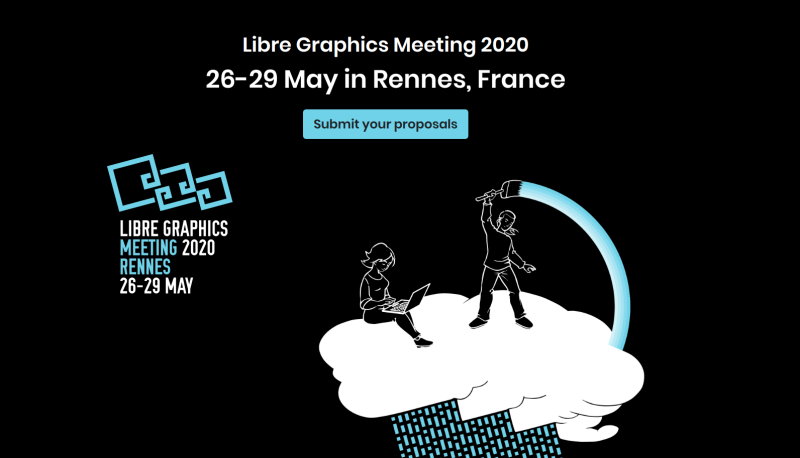
Update: sorry, the call for proposals is not yet ready, they are working on some technical fixes so please do not fill in the form yet. Watch out on social media for when it is ready.
The Libre Graphics Meeting (LGM) is the annual international convention for the discussion and development of free and open source graphics software.
This year it will happen in Rennes, France, from May 26th to 29th. We are welcoming all relevant projects to submit a proposal for a talk and/or a workshop. We already expect Krita and Kdenlive teams to be present. The Krita sprint will be held after the meeting and Kdenlive are planning to have a sprint around that time too. It would be awesome to also see some people from Plasma team working on graphics tablet support and color management, or any other topic of interest for developers and users of graphics creation application.
LGM are now asking for talks, workshops, BoF meetings and lightning talks for the conference. Please don't be shy and submit your proposal.
KDE e.V. has agreed to support the event by providing travel support to KDE contributors. If you are interested, make sure to file your reimbursement request before January 31st.
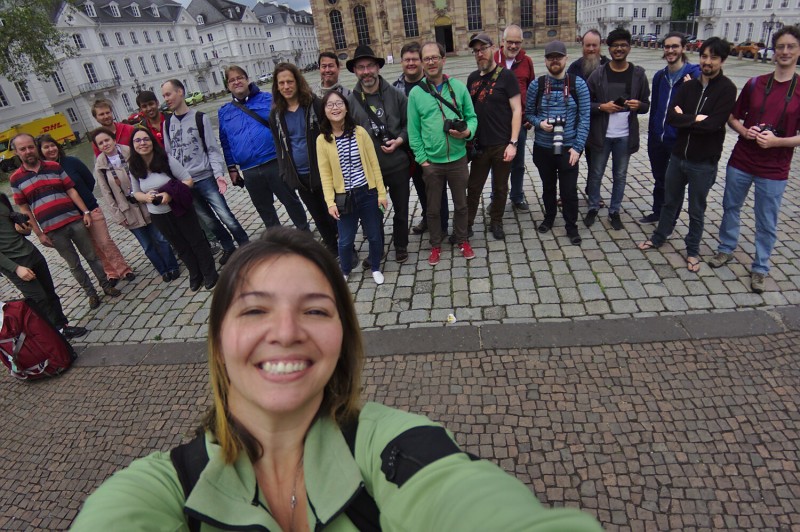
LGM 2019 -
Apps Update for November
(KDE)

LabPlot
The big release this month has been LabPlot 2.7. LabPlot is fast becoming one of KDE's highest profile apps. It is an application for interactive graphing and analysis of scientific data. LabPlot provides an easy way to create, manage and edit plots. It allows you to produce plots based on data from a spreadsheet or on data imported from external files. Plots can be exported to several pixmap and vector graphic formats.
In this release we made the user experience while working with LabPlot easier and more fun. Entering and working with data in spreadsheets is slicker and when reading live data from file sources you can now use a relative path to find a live data source. This allows you to, for example, copy the folder containing the project file together with the data file or files across different folders on your computer without losing the connection to the file or files. In the Project Explorer you can now move top-level objects to different folders via drag & drop.
The data picker, which allows you to digitize data points on images, has had an overhaul in 2.7. The devs have greatly simplified the overall workflow and the process of digitizing data points as you can see in this video.
Check out the Labplot YouTube channel for more videos on using this advanced application.
Bugfixes
Alternative panel Latte Dock got a bugfix release, 0.9.4. It fixes autoloading in some distros such as Manjaro.
KDevelop is on its monthly bugfix release which tidied up CLang support for some distros.
Over 100 apps gets released as part of the KDE Applications bundle which has just had its 19.08.3 bugfix releases and includes:
- In the video-editor Kdenlive, compositions no longer disappear when reopening a project with locked tracks.
- Okular's annotation view now shows creation times in local time zone instead of UTC.
- Keyboard control has been improved in the Spectacle screenshot utility.
Snap Store
Snaps are one of the new container-based package formats for Linux. KDE has over 50 apps published on the Snap store and ready to be installed on almost any Linux distro. On many Ubuntu flavors and derivatives, they come ready to be used. On others you may need to use your package manager to install snapd first. This is usually as simple as running a command such as
sudo dnf install snapdorsudo pacman -S snapd. Most of KDE's Snap packages are built by the KDE neon team on their servers and the aim is to get packaging and building integrated more directly with app's repositories and continuous integration setups. This means they are updated more frequently and the moment changes are made so you always get the latest and greatest features and fixes.New this month in the Snap store is KDE's video editor, Kdenlive.
Coming Up
We have a couple of nice progressions towards stable releases from KDE apps. First, the mobile journey search app KTrip has moved into kdereview, meaning the authors want it checked over for sanity before making a stable release. In a first for KDE developer Nicolas Fella, he worked out how to get KTrip into F-Droid, the free software app store for Android.
Then, the developer tool ELF Dissector passed kdereview, meaning KDE has approved it as something we are happy to put our name on when it gets released. It's a static analysis tool for ELF libraries and executables. It does things like inspect forward and backward dependencies (on a library or symbol level), identify load-time performance bottlenecks such as expensive static constructors or excessive relocations, or size profiling of ELF files.
Help Out
By getting KDE's apps into the most popular of channels like the Windows Store, Google Play and F-Droid, we can reach more users and boost KDE's adoption through its software. Now that Kate is successfully shipping in the Windows Store, Kate developer Christoph Cullmann wrote a guide to Windows Store submission. Check it out.
KDE's All About the Apps Goal has loads of other things you can do to help get our applications to users, so come along and give us a hand.
-
Apps Update for December
(KDE)

Creating new applications is the easy part. Maintaining them, making them safer and faster and adding features that make them more useful to users is what marks the difference between one-shot wonders and solid tools you can trust and enjoy for years. That is why KDE developers are constantly renewing and updating their applications, making them more reliable, more useful, and in general, just better.
What follows is just a minor sample of what you can expect from the latest round of updates for applications made by the KDE community over the last month:
Calligra Plan is Back
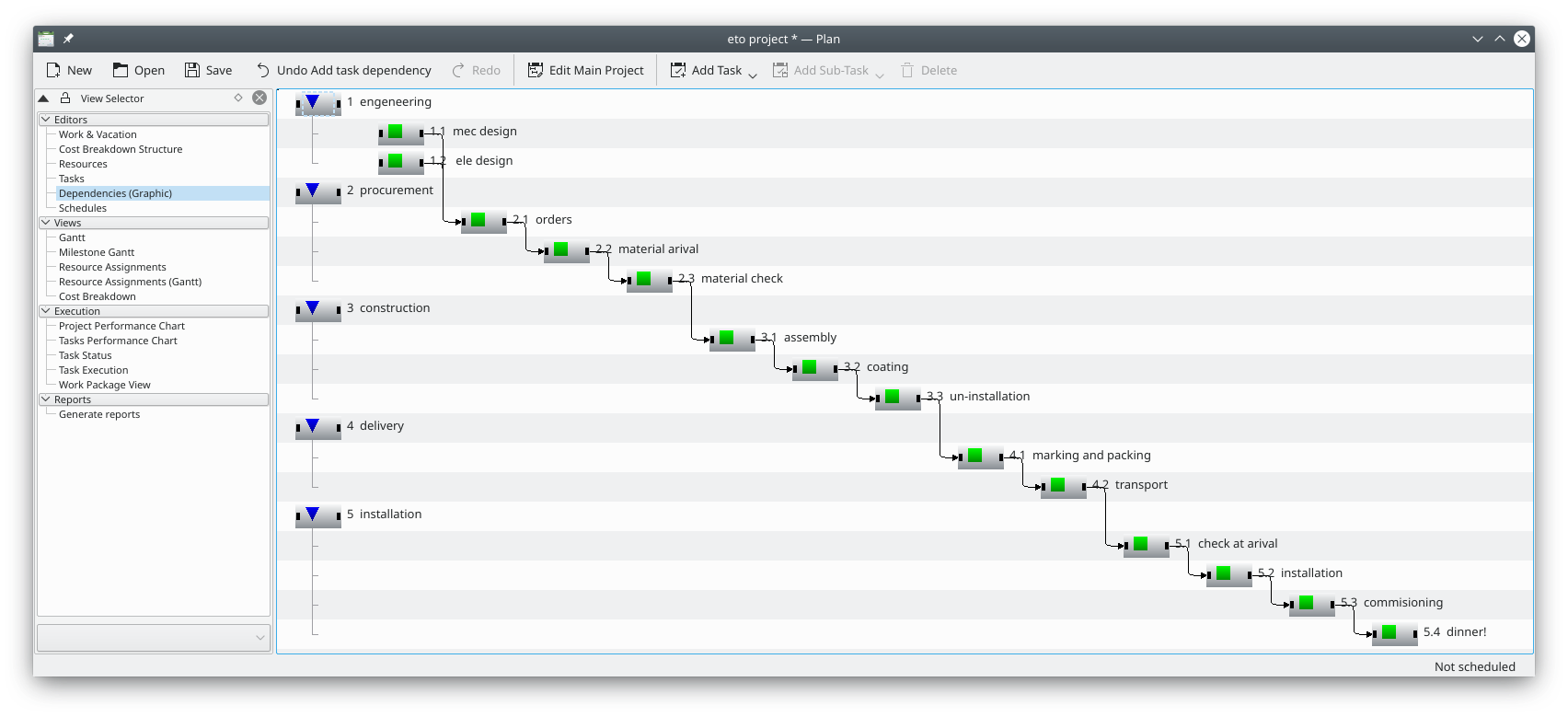
Calligra Plan lets you plan your projects in detail. Calligra Plan, KDE's project planning and management tool, gets its first big update in two years.
In case you were not aware, Plan helps you manage small and large projects which require multiple resources. In order for you to model your project, Plan offers different types of task dependencies and timing constraints. You can define your tasks, estimate the effort needed to perform each, allocate resources and then schedule the project according to your needs and the actual resources available.
One of Plan's strengths is its excellent support for Gantt charts. Gantt charts help you plan, coordinate, and track specific tasks in a project. Using Gantt charts in Plan you will be able to better monitor your project's workflow.
Kdenlive Pumps up the Volume

Kdenlive rocking a brand new audio mixer. Kdenlive developers have been adding new features and squashing bugs like crazy -- the latest version alone comes with more than 200 changes.
A lot of work has gone into improving support for audio. In the "bugs solved", department they have gotten rid of an error that would eat up memory. They have also made saving audio thumbnails much more efficient.
But the most exciting new feature is that Kdenlive now comes with a spectacular sound mixer (see image). Developers have also added a new audio clip display in the clip monitor and the project bin so you can better synchronize your moving images with the soundtrack.
Für Elisa
Talking of sound, Elisa is one of KDE's most popular up-and-coming music players. Elisa belongs to the deceptively simple, very light, very good-looking variety of players, with an intuitive and elegant interface and, in its latest version, Elisa has upgraded its looks even further to adapt better to High DPI screens. It also now integrates better with the looks other KDE applications.
Indexing music files has also improved and Elisa now supports web radios and comes with a few examples for you to try.
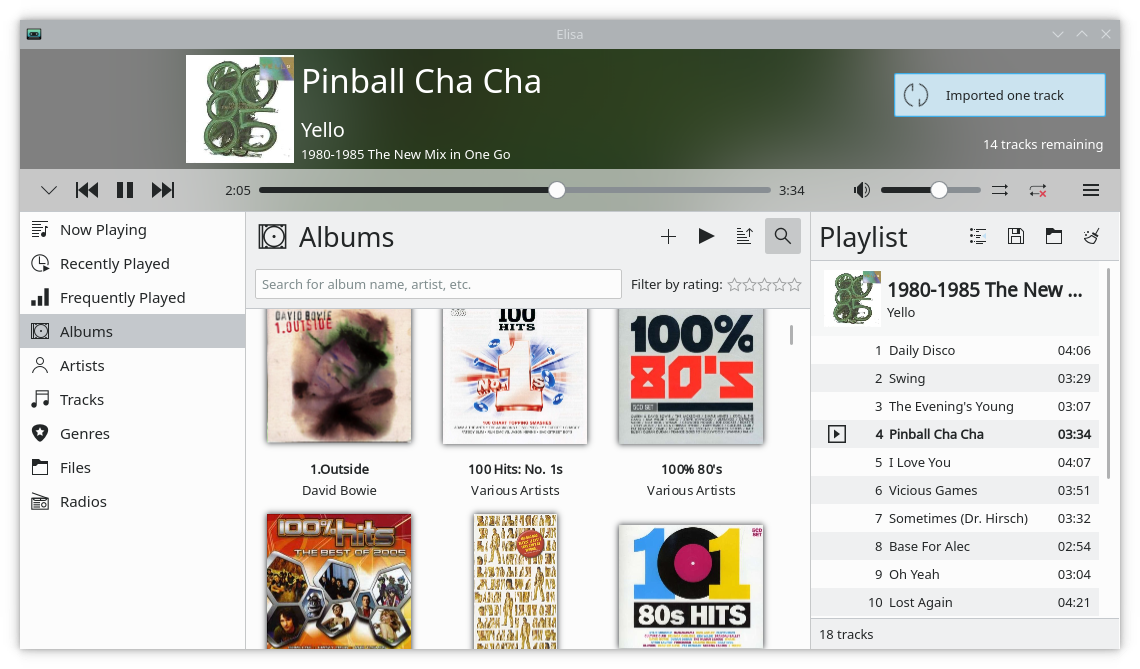
The Elisa music player.KDE Connect: Let Your Phone Rule your Desktop
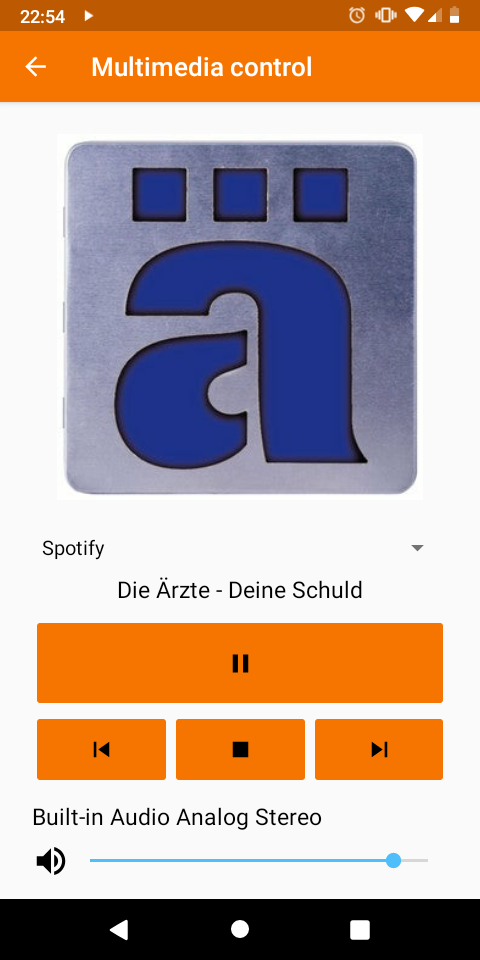
KDE Connect now lets you control
the global volume of your system.Most people who get to know KDE Connect, end up raving about it just because of how darned useful it is.
The latest version of KDE Connect packs even more features. One of the more noticeable is that there is a new SMS app that lets you read and write SMS from your computer with the full conversation history.
Developers are also adding new functionalities to existing features to make them even more useful. For example, you could already use KDE Connect to control the volume of media playing on your desktop, say, in VLC. But now you can use KDE Connect to also control your system's global volume from your phone. When giving a talk, you can control your presentation using KDE Connect to flip forward and back through your slides, and apart from integrating with other KDE apps, you can now also send files from Thunar (Xfce's file manager) and Elementary applications such as Pantheon Files.
Talking of other platforms, you can now run the mobile component of KDE Connect not only on Android, but also on all those mobile Linux platforms we'll be seeing in upcoming devices like the PinePhone and the Librem 5. The new version also provides features for desktop-to-desktop users, such as media control across desktops, remote input, device ringing, file transfers and running commands.
And Much More
But that is not all by any means: Dolphin, Spectacle, Okular and dozens of other applications have included new features you are sure to find useful. Even more projects, broaching apps, libraries and frameworks, have tweaked their code making them more stable and secure.
If you want to get an idea of the full range of changes, visit the official release announcement, or check out the changelog for every single detail of what has changed.
Getting applications made by KDE is also now easier: most are now available as Flatpaks, Snaps and AppImages. You just have to download them and they run straight out of the box. Many programs are also available for more platforms, such as Android, macOs and Windows. Krita and Okular have been available in the Microsoft Store for some time now, and they have recently been joined by Kile, a user-friendly LaTeX document editor.
Distributions will be updating their own repos and making the new versions available to Linux users over the next few weeks. Look out for your updates!
-
KDE releases Kirigami UI 2.0
(KDE)

Today, KDE announces the public release of Kirigami UI 2.0 !
All issues that were identified during the ten days of beta testing have been fixed, and Kirigami 2.0 is deemed ready for general use.
Soon after the initial release of Kirigami UI, KDE's framework for convergent (mobile and desktop) user interfaces, its main developer Marco Martin started porting it from Qt Quick Controls 1 to Qt Quick Controls 2, the next generation of Qt's ready-made standard controls for Qt Quick-based user interfaces. Since QQC 2 offers a much more extended range of controls than QQC 1, the port allowed the reduction of Kirigami's own code, while improving stability and performance. Kirigami 2 is kept as close to QQC 2's API as possible in order to extend it seamlessly.
Beyond the improvements that the port to QQC2 brings, further work went into Kirigami 2's performance and efficiency, and it also offers significantly improved keyboard navigation for desktop applications. On Android, Kirigami 2 integrates better visually with Material Design.
Of course there are also smaller improvements in various places, such as better handling of edge swipes in the SwipeListItem or more reliable activation of the Overscroll / Reachability mode (which pulls down the top of the page to the center of the screen where it can be reached with the thumb).
Discover (Plasma's software center), a quite complex application, has already been ported successfully to Kirigami 2 without much hassle, so we are confident that most applications can be ported easily from Kirigami 1 to Kirigami 2. Since Kirigami 2 requires Qt 5.7, which is not available on all Linux distributions yet, Kirigami 1 is still maintained (receiving fixes for critical bugs) for the time being, but won't receive any new features or improvements.
You can get Kirigami 2.0 via its wiki page, or from your distribution's repository as soon as it is packaged there.
If you want to try it out on Android, the Kirigami Gallery demo app is available on Google Play. -
Locations for GUADEC 2020 and 2021 announced!
(GNOME)
The GNOME Foundation is excited to announce that GUADEC, the annual GNOME conference, will be held in Zacatecas, Mexico in 2020, and in Riga, Latvia in 2021. GUADEC brings together hundreds of users and developers every year to further the GNOME Project, and it is one of our longest-standing and most noteworthy events. For the […]
-
ATK, GTK, and Plans for 2020
(GNOME)
The GNOME Project is built by a vibrant community and supported by the GNOME Foundation, a 501(c)(3) non-profit charity registered in California (USA). The GNOME community has spent more than 20 years creating a desktop environment designed for the user. We‘re asking you to become Friend of GNOME, with a recommended donation of $25/month ($5/month […]
-
KDE receives 200,000 USD-donation from the Pineapple Fund
(KDE)
KDE e.V. is announcing today it has received a donation of 200,000 USD from the Pineapple Fund.
With this donation, the Pineapple Fund recognizes that KDE as a community creates software which benefits the general public, advances the use of Free Software on all kinds of platforms, and protects users' privacy by putting first-class and easy to use tools in the hands of the people at zero cost. KDE joins a long list of prestigious charities, organizations and communities that the Pineapple Fund has so generously donated to.
"KDE is immensely grateful for this donation. We would like to express our deeply felt appreciation towards the Pineapple Fund for their generosity" said Lydia Pintscher, President of KDE e.V.. "We will use the funds to further our cause to make Free Software accessible to everyone and on all platforms. The money will help us realize our vision of creating a world in which everyone has control over their digital life and enjoys freedom and privacy".
"KDE is a vibrant community that has been developing a number of awesome products like Plasma that empower the user's freedom." said a spokesperson for the Pineapple Fund. "I especially admire the UX and design of KDE's products, as they are approachable to new audiences who are not Linux geeks. I hope this donation can power further KDE development!".
This donation will allow KDE to organize events that bring the community together; sponsor development sprints to improve the usability and performance of existing tools; pay expenses for contributors traveling from distant locations; attract more contributors and build a more inclusive community; create new and safer programs; and carry out research for future generations of KDE's environments and applications.
-
Call for GNOME.Asia 2020 Summit proposals
(GNOME)
The GNOME.Asia Committee is inviting interested parties to submit proposals for hosting the GNOME.Asia Summit during the second half of 2020. GNOME.Asia Summit is the featured annual GNOME Conference in Asia. The event focuses primarily on the GNOME desktop, but also covers applications and the development platform tools. It brings together the GNOME community in Asia to provide […]
-
Neil McGovern Named New GNOME Foundation Executive Director
(GNOME)
The GNOME Foundation is pleased to announce the appointment of Neil McGovern as its new Executive Director. McGovern officially starts work for the GNOME Foundation on February 15, 2017 and will operate from the United Kingdom. McGovern is an experienced leader in Free Software projects and is best known for his role as Debian Project […]
-
GNOME Shell 2019 Hackfest concludes in Leidschendam Netherlands
(GNOME)
The GNOME Shell 2019 Hackfest which took place in Leidschendam, Netherlands have concluded. During the Hackfest various discussions was held and work was done to improve Wayland integration with GNOME Shell, mixed DPI densities, Xwayland-on-demand, and more! Thanks go out to the Revspace Hackerspace for the venue. Reports from the Hackfest is available on the […]
-
Keeping the (server) lights on
(GNOME)
The GNOME project is built by a vibrant community and supported by the GNOME Foundation, a 501(c)(3) nonprofit charity registered in California (USA). The GNOME community has spent more than 20 years creating a free desktop environment designed for the user. We‘re asking you to join us by becoming Friend of GNOME. The GNOME Foundation […]
-
Plasma 5.17 is out!
(KDE)
KDE launches the new version of its acclaimed desktop environment, Plasma 5.17.
Plasma 5.17 is the version where the desktop anticipates your needs. Among many new features and improvements, your desktop now starts up faster; Night Color, the color-grading system that relaxes your eyes when the sun sets, has landed for X11; your Plasma desktop recognizes when you are giving a presentation, and stops messages popping up in the middle of your slideshows; and, if you are using Wayland, Plasma now comes with fractional scaling, which means that you can adjust the size of all your desktop elements, windows, fonts and panels perfectly to your HiDPI monitor.
The best part? The hundreds of improvements that have made their way into Plasma 5.17 do not tax your hardware! Plasma 5.17 is as lightweight and thrifty with resources as ever.
Check out the official release announcement for more features, improvements and goodies, or browse the full Plasma 5.17 changelog to read about every single change. You can also experience Plasma 5.17 for yourself and install one of the many distributions that offer Plasma.
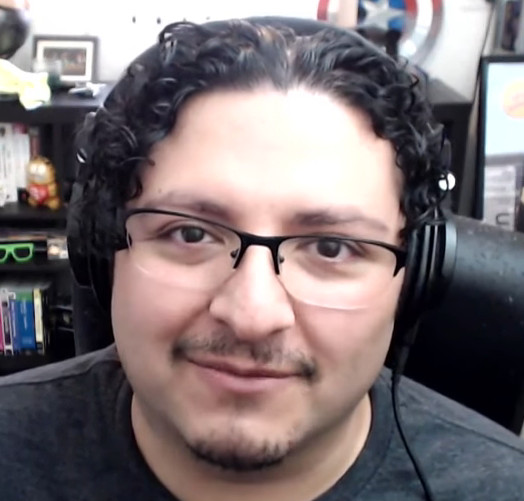
Guillermo Amaral The Plasma 5.17 series is dedicated to our friend Guillermo Amaral. Guillermo was an enthusiastic KDE developer who rightly self-described as 'an incredibly handsome multidisciplinary self-taught engineer'. He brought cheer to family, friends and colleagues. He lost his battle with cancer last summer, but will be remembered as a friend to all he met.
-
GUADEC 2016 to take place in Karlsruhe, Germany
(GNOME)
It is with pleasure that the GNOME Foundation is announcing that Karlsruhe, Germany, will host GUADEC in the summer of 2016. Karlsruhe is situated in the Southern part of Germany and is Germany’s sunniest city. It is easy to get to as it is a short trip from both Frankfurt international airport and Stuttgart airport. Karlsruhe combines a strong […]
-
GUADEC 2020 announcement
(GNOME)
The GNOME Foundation is excited to announce that GUADEC 2020 will take place between the 22nd – 28th of July in Zacatecas, Mexico. Zacatecas is a city and municipality in Mexico, located in the north-central part of the country. Set in a valley and surrounded by mountains, the city, which had its start as a […]
-
Akademy 2019 Talks Videos
(KDE)
We now have the Akademy 2019 videos ready for you to enjoy, see the previous summary of talks on the dot for some inspiration on what to watch. The talk schedule has the full list
We had keynotes on Developers Italia and the New Guidelines: Let the Open Source Revolution Start! by Leonardo Favario and Towards Qt 6 by Lars Knoll
We also got updates on KDE Community's goals
Another thing to check out are the previously announced BoF wrapups letting you know what went on during the week following the talks
Recommendations
Here are some talks recommended by attendees:
What we do in the Promos
Piyush: i attended Paul's talk. It was really nice to have an insight on promo's day to day tasks and challenges!
Strengthen Code Review Culture: rm -rf ‘Toxic Behaviors’
Philip: I liked the code review one
Valorie: and I agree, Aniketh's Code Review talk was excellent
Software Distribution: lightning talks & discussion
Jon: Software Distribution talk! (although I prefer my original name for it of Getting KDE Software to Users)
Taking KDE to the skies: Making the drone ground control Kirogi
Ivana: I nominate Eike's talk about Kirogi. It was such a cool talk that told the story of developing an app in a way that even non-devs could understand, and I think it really showcased how KDE is still going strong and taking the lead in the innovation game
Hannah: The talk was horrible.... It made me want to buy a drone
Mycroft on Plasma Automobile Demo
Bhushan: Automative demo one
About Akademy
For most of the year, KDE - one of the largest free and open software communities in the world - works online by email, IRC, forums and mailing lists. Akademy provides all KDE contributors the opportunity to meet in person to foster social bonds, work on concrete technology issues, consider new ideas, and reinforce the innovative, dynamic culture of KDE. Akademy brings together artists, designers, developers, translators, users, writers, sponsors and many other types of KDE contributors to celebrate the achievements of the past year and help determine the direction for the next year. Hands-on sessions offer the opportunity for intense work bringing those plans to reality. The KDE community welcomes companies building on KDE technology, and those that are looking for opportunities. For more information, please contact the Akademy Team.
Dot Categories:
-
conf.kde.in Is Coming Back In 2020
(KDE)
Join us for conf.kde.in from the 17th to 19th of January 2020 in Delhi, India.
conf.kde.in 2020 will focus on promoting Free and Open Source software, including (but not limited to) Qt and KDE products.
The Venue
conf.kde.in 2020 will be held in Maharaja Agrasen Institute of Technology, located in Rohini, Delhi, India. MAIT was established by the Maharaja Agrasen Technical Education Society and promoted by well-known industrialists, businessmen, professionals and philanthropists. The aim of MAIT is to promote quality education in the field of Technology.
MAIT endeavors to provide industry-relevant education and training through its well-crafted and practical training programs for the students in different semesters of their courses. The campus is composed of 10 blocks with a learning resource center. MAIT has been ranked as the 10th best private engineering institute in India by the Dataquest T-School Survey. MAIT always supports Free and Open Source communities and tech-related activities.
About conf.kde.in
conf.kde.in started in 2011 at RVCE in Bangalore as a 5-day event with 300 participants. This kicked off a series of KDE events in India. We held a KDE Meetup in 2013, and another conf.kde.in 2014 at DA-IICT. In 2015, the third conf.kde.in was held at Amrita University in Kerala, and in 2016 at LNMIIT Jaipur. The Jaipur conference attracted members of the KDE Community from all over the world. Attendees from different backgrounds came to meet each other, give talks, and share in the spirit of KDE. The 2017 conference was held in IIT Guwahati, Assam and sought to cater to new members of KDE, as well as to seasoned developers.
All of these events have been successful in attracting a lot of Indian students to mentoring programs such as Google Summer of Code (GSoC), Season of KDE, and Google Code-In.
conf.kde.in 2020 will generate even more interest and participation by creating a fertile environment for people to get started with KDE, Qt and FOSS through numerous talks, hands-on sessions and demonstrations.
Call For Papers
Join us! Submit a paper, explain the content for a 30-minute presentation or a workshop on any aspect of KDE, Qt or any other FOSS topic you want to cover, and become a conf.kde.in Speaker.
Remember to include all pertinent information about your background, other talks you've given, and anything else that gives a sense of what attendees can expect from your presentation.
See you in 2020 in India!
-
GNOME Asia Summit 2019 to take place this weekend in Gresik, Indonesia
(GNOME)
GNOME Asia Summit 2019 will take place this weekend in Gresik, Indonesia. The main focus is primarily on the GNOME desktop, but also applications and platform development tools are covered. The summit brings together the GNOME community in Asia to provide a forum for users, developers, foundation leaders, governments and businesses to discuss the present […]
-
GNOME in 2019
(GNOME)
2019 represented an exciting year for GNOME with many things happening. GUADEC, GNOME’s biggest annual conference took in 2019 place in Thessaloniki, Greece while GNOME.Asia Summit (GNOME’s second major conference) was organized in Gresik, Indonesia. Both events were considered successful. In addition to the conferences, the community organized several Hackfests in different locations each gathering contributors […]
-
GNOME files defense against patent troll
(GNOME)
Orinda, CA – 2019/10/21 A month ago, GNOME was hit by a patent troll for developing the Shotwell image management application. It’s the first time a free software project has been targeted in this way, but we worry it won’t be the last. Rothschild Patent Imaging, LLC offered to let us settle for a high five figure amount, for which they would drop […]
-
GNOME acknowledge AWS Sponsorship
(GNOME)
The GNOME Foundation wants to recognize AWS for donating credits that have allowed us (GNOME) to taking advantage of the multitude of services Amazon provides. In particular, the GNOME Infrastructure utilizes AWS S3 service as a file store for the multitude of Docker images that are generated or updated daily. GNOME uses GitLab as its […]
-
Consistency Update
(KDE)
By Niccolò Venerandi

It's been a month since Consistency was announced as an official goal for KDE at Akademy. During this time, we have focused on setting up all the tools needed to support the goal and tracking already active consistency tasks. Here's an update on what we have done so far and the main tasks we're working on.
Community Page
We have created a Consistency page on the community wiki where you can learn what the consistency goal is and find out how you can easily get involved in it. Check it out, regardless of your level of technical expertise!
Matrix Channel
There is also a Consistency channel on KDE's Matrix instance. Access it through the webchat page or at consistency:kde.org. You are welcome to come in and join us to discuss anything related to the consistency goal!
Sprint!
A sprint is in the works. If you would like to participate, join in the discussion and come and discuss the time and the place on the Matrix channel as well.
Phabricator Workboard
We created a Consistency workboard so you can track all the tasks and keep up with their development. You can add yourself as a member or watcher to receive Phabricator updates.
Tasks are organized into the following categories:
- Reported shows consistency problems that still need to be addressed, but are currently not being worked on, or are not actively developed yet
- VDG Discussion lists tasks that the VDG (Visual Design Group) are discussing
- HIG Specification shows tasks that are waiting for an HIG (Human Interface Guidelines) specification so they can be developed in a consistent way
- Under Apps Implementation you can find tasks that are actively being worked on
- Meta contains all the tasks that are not exactly consistency problems, but are related to the consistency goal in some way
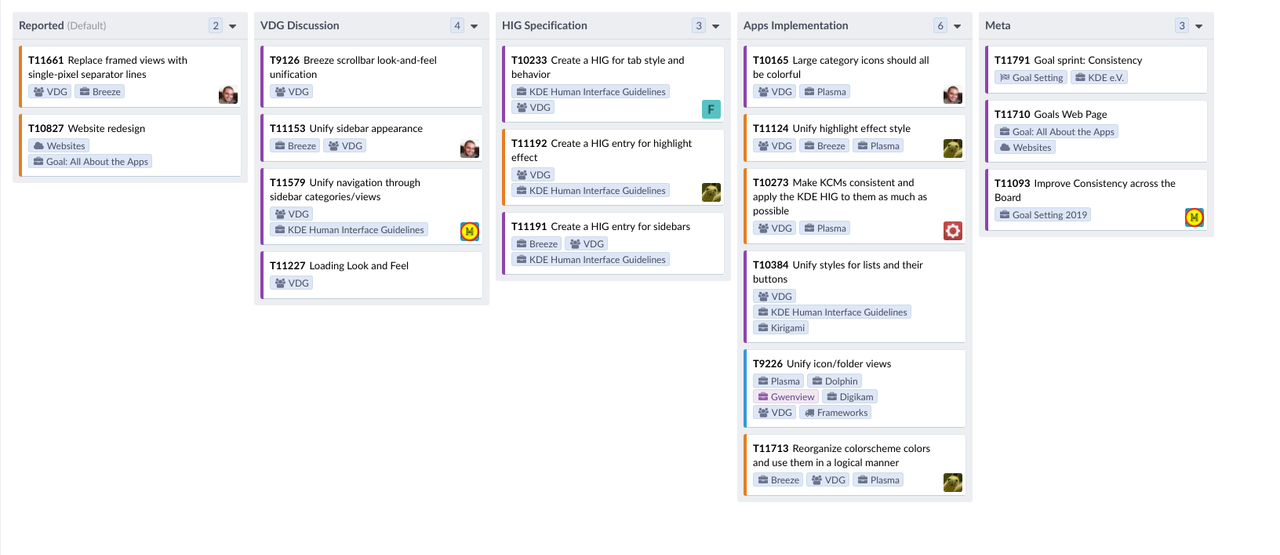
The Consistency goal's workboard.Consistency Tasks
There are already many tasks in the Consistency project. Some tasks are new, some existed before. Many of these tasks are quite interesting, so read on to get an idea of what lays ahead for this goal.
Unify Highlight Effect Style
This task was already in progress when the Consistency goal was selected, but it is nevertheless a great example of what we'd like to see happen in the goal.
Currently, Plasma has a discrepancy in its highlight effect. The first kind of effect is a plain rectangle using the highlight color, while the second one is a rounded rectangle with an outline and semi-transparent background. Although the former is more common, we think the latter is more appropriate to use in all situations.
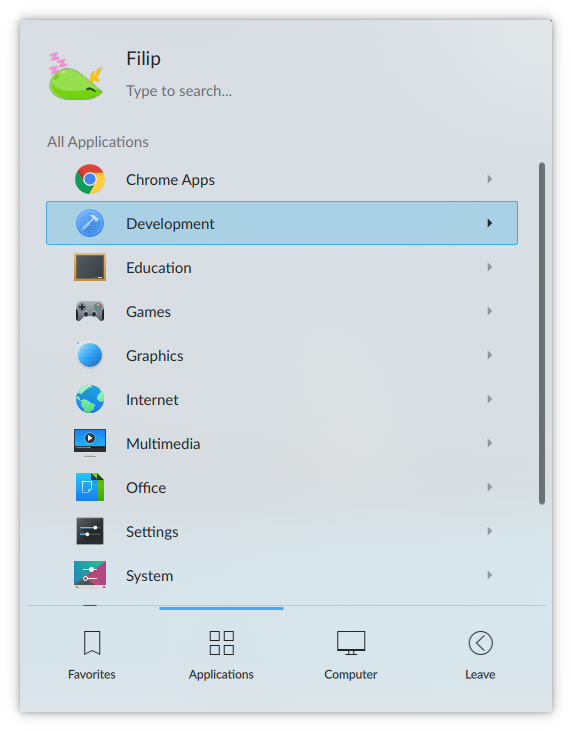
Here's the correct highlight effect in Plasma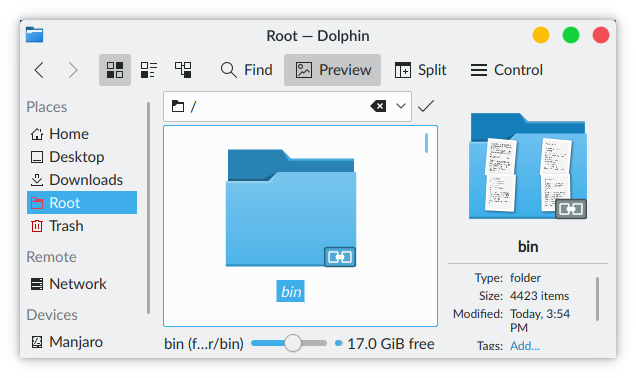
Here's what it looks like in Dolphin now.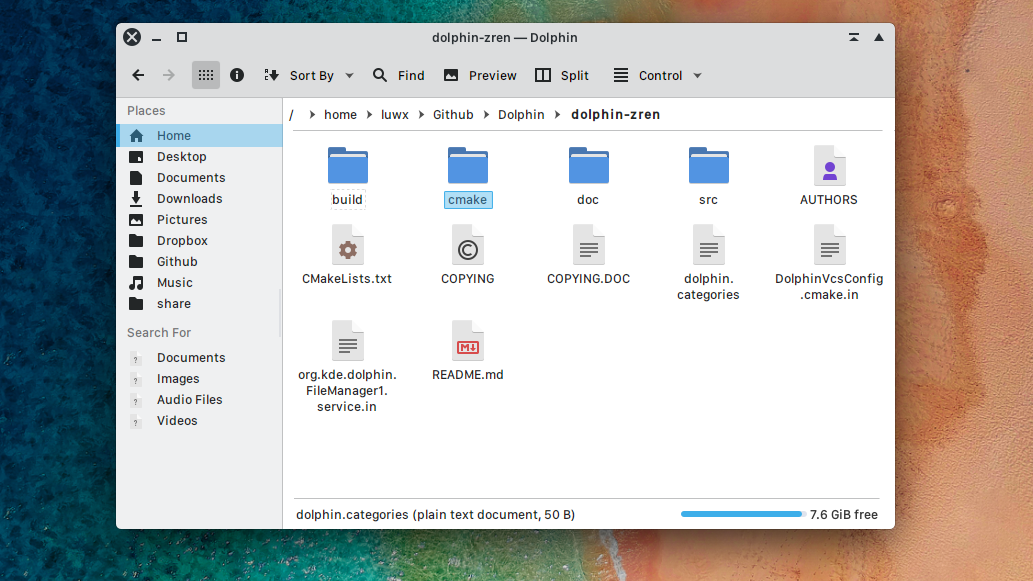
Dolphin mockup showing correct highlighting.A few more examples of what the new highlight could consistently look like in various use-cases:

Big icons sidebar highlight.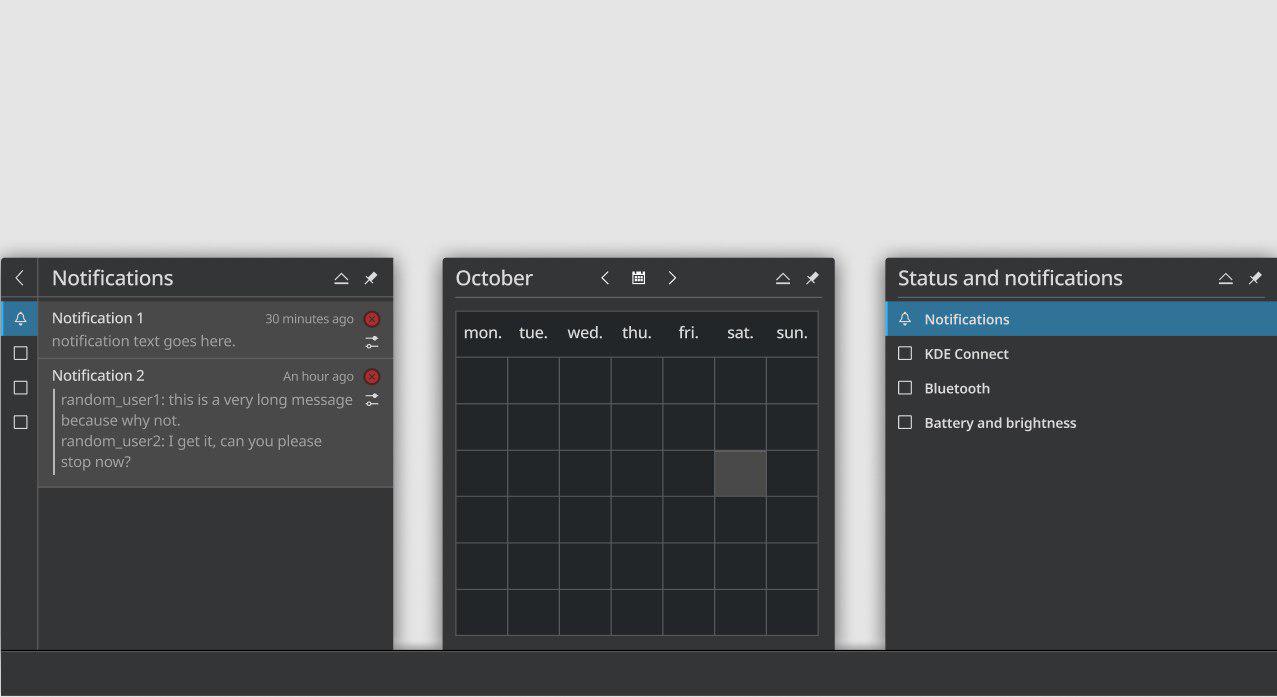
In plasmoids.
In menus.This is a great example of what consistency can be: not simply applying the same style everywhere, but finding something that a single app does very well, and bringing that to all the other apps. Noah Davis is actively developing this task, and he's doing a great job!
Unify Sidebar Navigation and Appearance
These tasks originated directly from the Consistency goal.
Sidebars are used in many applications and it would be great that they were consistent. There are two main aspects to this: the type of sidebar (system settings-like lists, big square icons, etc.) and the navigation within the sidebar (tabs, combo boxes, etc.).
What is the best solution? That part is currently under discussion. We welcome everyone's opinions on the matter or, even better, an expert assessment on the feasibility of each of the options.
Let's quickly illustrate some options:
For the sidebar appearance, the current main option relies on using lists and big square icons, depending on the number of elements:

Sidebars.On the other hand, the option for navigating sidebar views includes tabs that become icons-only when horizontal space is insufficient, vertical tabs on the left, and combo boxes:

Option 1.
Option 1b.
Option 2.
Option 3.Furthermore, Nate Graham is focused on making sure that all big icons displayed in sidebars are colorful. He has already fixed a lot of them, and only a few are missing that we know of. Finally, there's also a task to create an HIG specification for sidebars as soon as the discussion settles. We welcome help with any of these tasks. :-)
Website Redesign
This task was already ongoing when the Consistency goal was chosen and it aims to modernize old web pages that follow obsolete styles. There are many of them and some are well-hidden. Carl Schwan created and works on this task alongside many other contributors. Check it out and see if you too can find any old websites that need updating!
That's the end of this update!
If you would like to help out, come join us in the matrix room and let's make KDE software more consistent together!
-
Host Akademy 2020 in your City!
(KDE)
By Aleix Pol

Hosting an event is a big and significant way of contributing to Free Software. One of the biggest challenges in international distributed teams like KDE is communicating effectively with one another. Akademy, the yearly global conference of the KDE community, solves that by bringing the community together in one place, allowing us to share what we have been up to and have it reach its potential.
By organising Akademy we are then turning one of our weak points into a strength. We get to work together like a local team does, while remaining flexible and geographically distributed for most of the rest of the year. It becomes therefore one of the best ways for Free Software to thrive in your area.
What is Akademy
While Akademy has evolved over the years, its main structure remains similar: We have two conference days, the KDE e.V. Annual General Meeting and few days with smaller meetings and trainings. Akademy is open for everyone to join and participate, regardless of their background, studies or origin.
We would like you to consider hosting Akademy. We could look into doing it in 2020, although if you think this is too short-notice, 2021 could also be discussed.
You can find the full description of what's necessary in this simple-to -follow brochure. Reach out to the KDE e.V. Board and the Akademy team and put your thoughts in action.
-
Step up and become a Friend of GNOME!
(GNOME)
The GNOME project is built by a vibrant community and supported by the GNOME Foundation, a 501(c)(3) non-profit charity registered in California (USA). The GNOME community has spent more than 20 years creating a desktop environment designed for the user. We‘re asking you to step up for GNOME and become Friend of GNOME. We're working to have 100 new Friends of GNOME join by January 6, 2020.
L'actualité de cette partie est agrégé automatiquement à partir d'autres sites.
Contenus ©2006-2024 Benjamin Poulain
Design ©2006-2024 Maxime Vantorre
